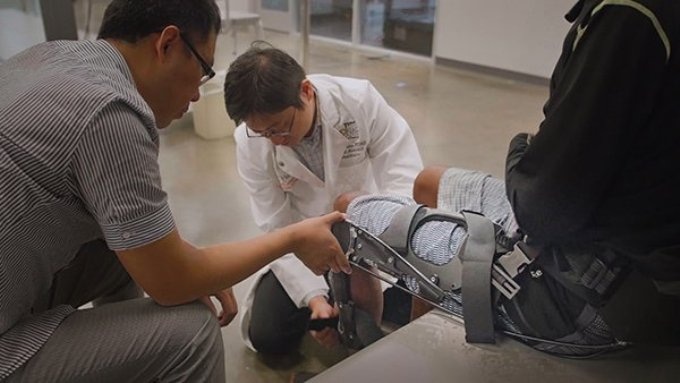Dec 17 2019
The City University of New York, City College (CCNY), and The University of Texas Health Science Center at Houston (UTHealth) have developed a new range of wearable robots that can keep senior people on their feet for a longer time.
 UTHealth’s Shuo-Hsiu (James) Chang, PT, PhD (center), and CCNY’s Hao Su, PhD, are testing a mobility device for seniors. Image Credit: The University of Texas Health Science Center at Houston.
UTHealth’s Shuo-Hsiu (James) Chang, PT, PhD (center), and CCNY’s Hao Su, PhD, are testing a mobility device for seniors. Image Credit: The University of Texas Health Science Center at Houston.
The wearable robots can be visualized as a lightweight model of the armor worn by comic hero Tony Stark to fight enemies, in the form of Iron Man. Such mobility machines are known as exoskeletons.
Hao Su, PhD, of CCNY, developed a prototype that was tested by Gerard Francisco, MD, as well as Shuo-Hsiu (James) Chang, PT, PhD, from the McGovern Medical School at UTHealth. The prototype worked well in a pilot study carried out on people who have walking problems. Su works as an assistant professor at CCNY.
Now, a $1.3 million grant from the National Institute on Disability, Independent Living, and Rehabilitation Research (NIDILRR) has allowed Francisco, Chang, and Su to test the prototype on senior people who have difficulties with their stride or gait.
According to the U.S. Census Bureau, mobility is the most frequent disability among people aged 65 years or above in the United States. Moreover, 32% of adults aged 65 years and above find it difficult to walk even three city blocks, as reported by the Journal of Public Health.
Traditional exoskeletons are usually costly, bulky, heavy, and are mainly suited for those who have limited voluntary movements.
Our prototype is approximately 60% lighter than commercially available exoskeletons. In addition, our model is run by the user, not the robot. Wearers aren’t forced to walk in a pre-defined path.
Gerard Francisco, Wulfe Family Chair in Physical Medicine and Rehabilitation, McGovern Medical School
Francisco is also the chief medical officer at TIRR Memorial Hermann.
According to him, powered lower-limb exoskeletons can benefit about 4.7 million people in the United States, specifically those who have neurological disorders such as spinal cord injury, stroke, multiple sclerosis, and polio.
Our long-term vision is to make assistive robots accessible to everyone who needs them. They could be worn underneath your clothing at home or at work.
Shuo-Hsiu (James) Chang, Assistant Professor of Physical Medicine and Rehabilitation, McGovern Medical School
Chang is also the administrative director of the NeuroRecovery Research Center at TIRR Memorial Hermann.
Chang continued, “Despite the advancement of exoskeletons, state-of-the-art exoskeletons are not suitable to promote independence and community living. There is a pressing need for wearable robots that can improve the quality of life for broader populations in community settings.”
Richard Petty, MBA and a co-director of the Independent Living and Research Utilization program at TIRR Memorial Hermann, is the co-investigator in the study.
The study was supported by the NIDILRR, which is part of the National Institutes of Health, (90DPGE0011). It is titled as “Lightweight and Affordable Soft Knee Exoskeletons to Enhance Independent Living for Broad Lower-Limb Disability Populations.”